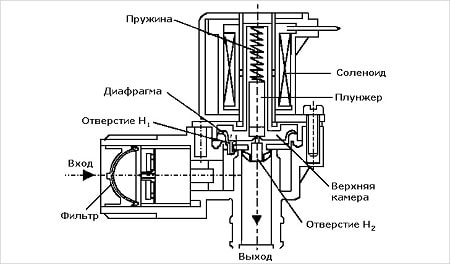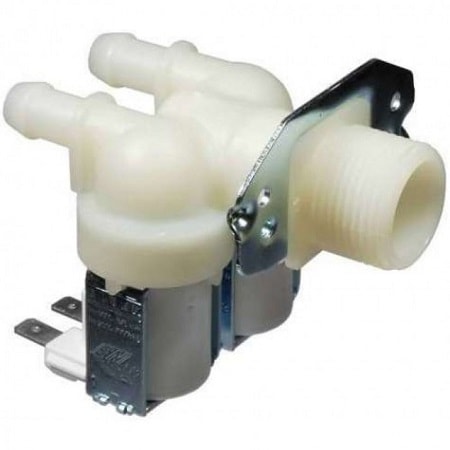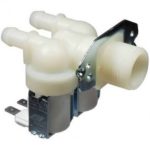In any model of the washing machine, the most important element is the inlet valve for the washing machine, sometimes referred to as the inlet valve. In this article, we will tell you how this structural element is arranged, describe the principle of operation, and what types exist.
Design and principle of operation

Washer inlet valve, has two types of operating state - open and closed. In the second state, he arrives most of the time. A coil is installed inside the valve, to which the program supplies electric current, which is a signal to open the valve, which accordingly leads to filling the working space of the machine with water. This principle of operation gave rise to another name for the valve - electromagnetic.
When the tank is filled to the required level, the control program transmits a second signal to the filling valve, after which it closes and the liquid ceases to flow into the system.
In almost all models of washing machines, the valve is located in the upper part of the structure, near the back wall. But in those machines where the laundry is loaded vertically, the valve is located in the lower part of the unit, also near the back wall. In the first case, to get to the element we need, you need to remove the back cover, and in the second case, the side panel is dismantled.
![]() See also - Do-it-yourself damper replacement in the washing machine
See also - Do-it-yourself damper replacement in the washing machine
Types of inlet valves for the washing machine
 These locking mechanisms are of various types. The operation mode of the valve based on an electromagnet has been described above, however, in reality, the operation process is a bit more complicated. The water in the washing machine must be supplied through several hoses in the programmed period of time. The simplest valves have one such electromagnet, and the flooded water was distributed over the machine using the mechanism of the command device. However, these units can no longer be found on sale, since they are morally obsolete in technological terms.
These locking mechanisms are of various types. The operation mode of the valve based on an electromagnet has been described above, however, in reality, the operation process is a bit more complicated. The water in the washing machine must be supplied through several hoses in the programmed period of time. The simplest valves have one such electromagnet, and the flooded water was distributed over the machine using the mechanism of the command device. However, these units can no longer be found on sale, since they are morally obsolete in technological terms.
Today inlet valve for washing machine has a more complex structure, where the internal device is divided into many sections, and each of them has its own electromagnet. Accordingly, each section is connected to a specific place where water is required, and as necessary, the control program gives signals and activates the coils. Therefore, we can safely distinguish the following types:
- single coil valves;
- with two coils;
- with three coils.
Also, now all coils have a completely electrical structure, they completely lack mechanical components.
How to check the valve for functionality
To determine the health of the valve, it must be removed. Then, connect the water supply hose to it, and supply current to the coils. If the unit is in good condition, the valve will open and let water through. After stopping the supply of voltage to the coil, the locking mechanism should close. This check is very easy and will not cause any particular difficulties, but it must be done carefully, since you work in high humidity conditions with an electrical appliance, in no case do not allow exposed wires to come into contact with liquid.
Also, it is necessary to check the following units of the unit:
- It is necessary to check the filter screen on the valve and clean it of dirt.
- If the valve does not open, you should check if the solenoid coil in it is burned out, for this use a multimeter. The resistance of the working coil varies in the region from 2 to 4 Ohms.
- Check the presence of plastic elements in the valve fittings, they are designed to contain the pressure of water. If these inserts are not available, then this structural element must be replaced.
Valve replacement
The inlet valve of the washing machine is a non-separable part; therefore, it cannot be repaired. This replacement operation is carried out as follows:
- First, it is necessary to de-energize the washing machine, then turn off the water supply and dismantle the back cover.
- Disconnect all hoses from the valve, remember the main thing, which one, where it was installed.
- Then unscrew all the fasteners holding our part.
- Remove the old valve.
- Next, install a new element, and in the reverse order, reassemble the washing machine.
After completing all the necessary points, check the performance of your unit, whether water is supplied and whether everything is functioning correctly.
See also:

